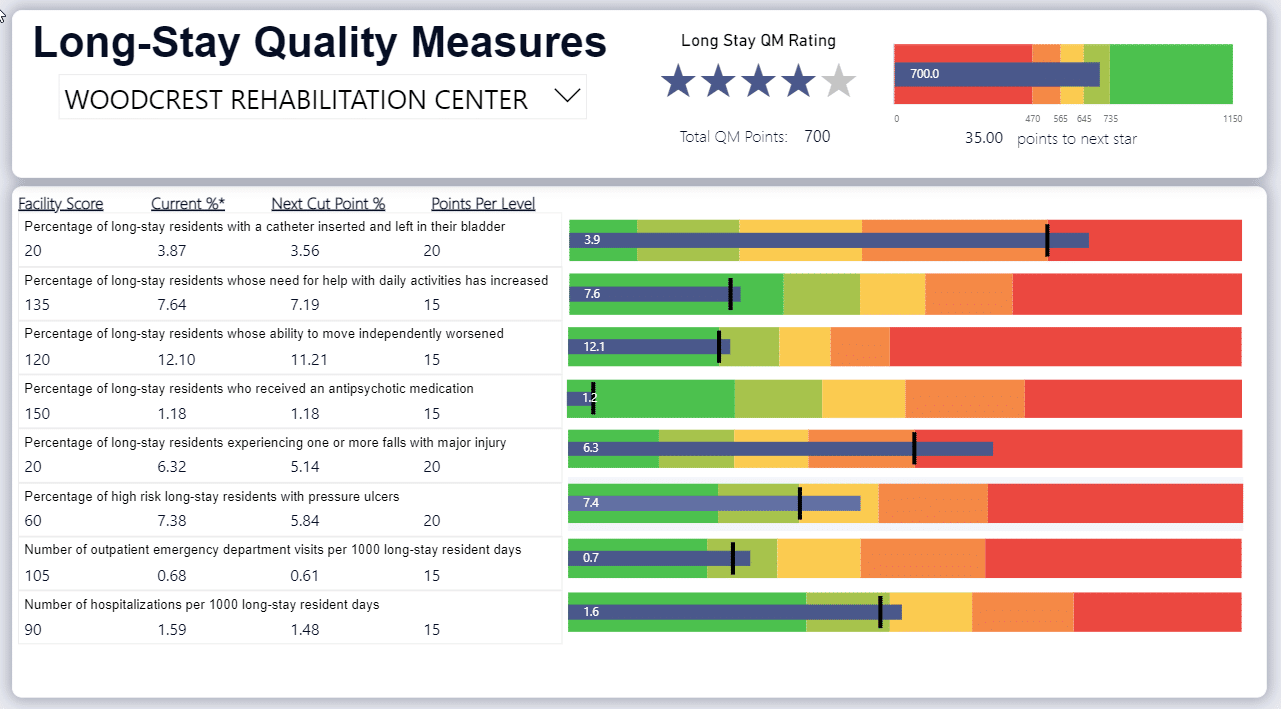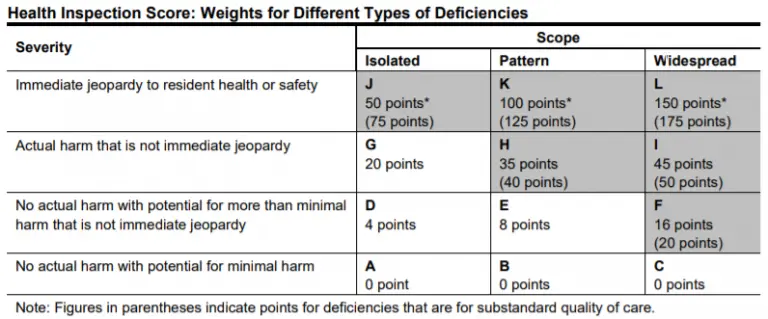
It’s tough to overstate the importance of the Centers for Medicare and Medicaid Services’ (CMS) Five-Star Quality Ratings to nursing homes and their residents.
Given how crucial the rating has become, what can nursing home or skilled nursing facility (SNF) administrators do to efficiently improve their facility’s nursing home star rating on Nursing Home Compare?
First, let’s take a quick look at how the score is calculated.
The CMS Five-Star rating consists of three main components (or domains):
Each of these domains receives a rating on a five-star scale.
CMS then calculates the overall rating by adjusting the number of health inspection stars up or down in response to particularly good or poor staffing and quality measure scores.
Now, let’s look at the three rating domains in detail and outline a strategy for improving your score in each one.
The bulk of a nursing home’s star rating comes from its health inspection score. The health inspection acts as a baseline for the overall star rating. Excellent performance in the staffing and quality measure domains can improve the inspection score, but not by more than two stars. And a one-star health rating guarantees that a facility’s overall rating will fall below average. So, it’s crucial for administrators to do all they can to position their facility for a successful health survey.
The health inspection score itself is based on noncompliance points assigned to a facility during:
Facilities with the least noncompliance points receive the highest scores. Nursing homes with scores that rank in the top 10% in their state earn a five-star health inspection score. The lowest 20% receive one star. And CMS gives the remainder an even distribution of two, three, and four stars.
CMS health inspectors assign the most points to widespread and dangerous deficiencies as per the chart below.

Source: www.cms.gov
Given that certain deficiencies carry penalties as high as 175 points, administrators should strive to thoroughly educate staff on state health regulations so that they can identify and correct particularly severe deficiencies before the survey team arrives.
In a similar vein, if the inspectors flag your facility for specific deficiencies that require a revisit, work to correct them immediately. If you don’t accomplish this satisfactorily before the time of the revisit, CMS will assign you an additional 50% of the flagged deficiencies’ points. Any additional revisits run the risk of even higher penalties as shown in the table below.

Source: www.cms.gov
Common strategies for improving a facility’s performance during health inspections include mock surveys and chart audits. Both can spot potential problem areas before they are flagged by inspectors. Unfortunately, while they are an essential component of good practice, they can lack focus, leaving administrators with little direction as to where to devote limited resources and staff time.
In response to this problem, some third-party analytics packages alert users to deficiencies that were recently flagged at nearby peer facilities. The logic being that if inspectors are on the lookout for specific areas of noncompliance, administrators get advance warning to correct them before the survey team arrives at their facility. DashPoint’s Five-Star Comparative Analysis dashboard identifies the five most common recent tags in the user’s state.
But there are few quick fixes. Improving your SNF’s health inspection rating is a long-term, painstaking process. This is, in part, because the rating is a weighted average of the three most recent surveys. The most recent survey (Cycle 1) is worth 50% of the total score. Cycle 2 and Cycle 3 account for 33% and 17%, respectively. Thus, an exceptionally good score on a single survey likely won’t improve a facility’s overall quality score by more than one star.
Also, by it’s nature, the health inspection tends to be more qualitative than the scoring process for other components of the CMS star rating, making the rating difficult to predict.
For the administrator looking to improve an overall quality score quickly, the staffing score is a good place to start.
The staffing score will boost a facility’s overall score by one star if it:
So, how do you improve the staffing score?
Let’s first take a look at how CMS calculates the rating. The scoring process sources data from the Payroll-based Journal (PBJ) and is based on two case-mix adjusted ratios:
Each of these ratios receives a star ranking determined by the cut points in the chart below:

The overall staffing score is usually the arithmetic average of the two star rankings. If, for example, a facility’s total nursing score was five stars and its RN score was three stars, then the overall staffing score would be four. If, however, the average is not a whole number, the overall staffing score is rounded toward the RN score. Thus, SNF’s with a higher proportion of RNs on staff tend to perform better on the staffing measure than those that don’t.
So the key to boosting your staffing score (and potentially your overall star ranking) is to attract and retain an adequate number of registered nurses.
DashPoint’s Five-Star Comparative Analysis Dashboard can help nursing home administrators see exactly where their facility’s staffing scores stand in relation to the nearest star cut points, making it clear exactly how many more RN FTEs must be added to raise the overall ranking to the next level.

Source: DashPoint Analytics
CMS awards quality measure (QM) stars based on a nursing home’s performance according to 15 metrics, with data sourced from the Minimum Data Set (MDS) and Medicare claims.
The QM score only impacts a facility’s overall rating in the event that it is assigned one star or five stars. If it’s one star, it drags the overall score down one star. If it is five stars, it increases the overall rating by one star. A QM score of two, three, or four stars has no effect in any case.
So, the goal is to boost the QM score to five stars. To do this, take a close look at your facility’s QMs. Each one is divided by cut points. The better a facility’s performance is on a specific QM, the more points it receives. To earn a five-star overall QM score, a facility must collect at least 1475 QM points out of a possible 2300.

If your facility has narrowly missed a higher cut point, it is an opportunity to raise your score. Compare your QM scores to the cut point information published in the CMS’s Five-Star Quality Rating System User’s Guide to identify specific QMs that, with a slight improvement in clinical care, will give you the 1475 points you need to earn the five-star rating.
While chart audits, staff training, and mock surveys remain fundamental to improved service delivery and resident care, a little insight into the Quality Rating System’s scoring process can pay big dividends in terms of boosting a SNF’s star rating.
One drawback of relying on the analysis of past performance to improve your star rating is that it’s difficult to see the results of your team’s corrective actions as they are made.
Are you interested in collecting QM data in real-time? Check out the live demo for our Real-Time QMs and CASPER Dashboard here.
Ryan Hoover
Ryan is a Data Analyst at DashPoint Analytics.